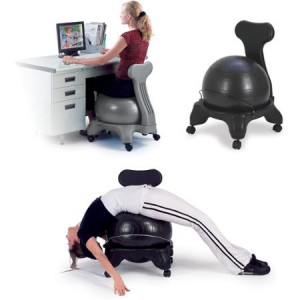
10 tips for using a standing desk will be looking at a number of things that will make it easier to embrace this new lifestyle. You have made it to the standing position so congratulations are in order. Your legs may be shaky, your arms trembling, but you have managed to stand. (Applause from your co-workers as you clutch your monitor in triumph and to steady yourself.) The first thing to realize is that standing at your desk will be a new habit. I will cover the main areas that can detract or prevent adopting this worthy health habit.
Don’t Ditch Your Chair
1)The first tip is not to completely ditch your chair.
Avoid the extremes of sitting for 8 hours a day or trying to stand for that amount of time. What may come to mind when first using a standing desk is an all or nothing attitude.
However, standing for hours at a time has its own drawbacks. If you stand for too long, other injuries may present themselves. Painful, stiff legs along with aching back and shoulders for starters. Curb the initial enthusiasm you may feel and take it easy or try a sit stand stool.
Do not stand for too long especially in the beginning phases of your standing desk journey.
Find Your Own Rhythm
10 tips for using a standing desk includes finding the best sit/stand rhythm for you. I personally sit for 6 hours and stand for 10 minutes–just kidding. I like to sit for about 40 minutes and then stand for an equal amount of time. Some people prefer blocks of sitting and standing for a few hours. It is recommended that for every hour of sitting you get up and boogie. Take a break and dance or stretch. Work up to spending about half your work day standing.
2) Find your own sitting and standing rhythm and timing.
Comfortable Footware
Wear sensible shoes. No, not tap dancing shoes. Take an extra pair of jogging shoes to work that are comfortable. Some shoes, especially stilettos can really play havoc with a standing session. You will need some extra cush, so perhaps consider an anti-fatigue mat. The amount of time you can stand comfortably increases dramatically when you use the right footwear and an anti fatigue mat.
3) Use sensible shoes and an anti-fatigue mat.
Standing Correctly
Avoid obvious slumps or overextensions of your posture. Gently squeeze your buttocks muscles together. Just drop your hands in a relaxed fashion down to your sides. Gently tighten your stomach muscles.
When we feel tired we can be inclined to slump over the desk or hold on with our hands. Stay light and relaxed and remember the shoulders and neck may scrunch when they are feeling stressed so consciously relieve them by letting them drop down. Swivel the neck around slowly to relax the neck and head. Notice where tight locked muscles in your body are situated so that you can relax them. Look up to change your posture.
4) Be aware of your posture, especially when you start to slump. It is a clue that you need to be seated.
Ergonomic Factors
Keep your monitor(s) at eye level.
The surface holding your keyboard and mouse should be slightly below elbow height.
Elbows must bend at a 90 degree angle.
Eyes should be at about 20 to 28 inches from your monitor.
The monitor should have a 20 degree tilt.
5) Keep the ergonomics of your work station in mind for comfort and enhanced productivity.
Don’t Forget The Eyes
Eyes are another big area of strain in the technoage. Roll your eyes around in their sockets to prevent eyestrain and gently rub them. Study those fly droppings on the air conditioner. 10 tips for using a standing desk does not include getting fired for gazing wistfully out of the window. It can help though. Vary your focus and look at objects some distance away, like your boss watching you and perhaps wondering what you are up to.
6) You are using your eyes for so many tasks, give them regular breaks to avoid fatigue.
Use a Balancing Ball or Motion Stool
These are also known as a stability ball and are great for using all the muscles.You may have seen them in the gyms, but now they are being used more frequently in the office. The main muscles they target are the abs, trying to balance and stay seated will give you a good ab workout.
They can be softer and more pliable than the normal office chair so this is also helpful for circulation. You will feel it in your back, legs and butt, so don’t overdo this or you could wind up with stiff sore muscles the next morning.
A healthier alternative may be the balance ball chair. Do not spend extended time periods on the ball. Once again, balance is the way to go. A new kid on the block is the Motion Stool. These allow you to sit and stand and are adjustable.
7) Using a balance ball chair or a motion stool like Mobis or the Swopper will allow you to remain active while seated.
Be Willing To Experiment
Remember you are undoing the bad habit of sitting for long periods so the change can feel strange to begin with. Experiment to see what tasks you can do easily while you are standing. I find that taking calls is a good time to stand. Emails are another one.
More detailed work like excel spread sheets and some graphic design tasks may require more concentration. Eventually, you will be able to manage even complex tasks as you get more used to standing.
8) Experiment to find what works for your own particular body type and disposition.
Move Around a Bit

10 tips for using a standing desk loves this one. Stretching is a great way to feel some relief. Try some desk chair exercises. Change from standing to stretching, desk yoga, under desk exercises and plain old fidgeting.
You may appear to be very restless to your coworkers but persist and they may eventually even join you.
Just plain standing in one spot can really fatigue you quickly so keep moving. The body was meant to move so stretch, shake the hands and feet reach for the air conditioning.
If you have the freedom to do so, incorporate a few light weights and maybe even a stationary cycle or desk treadmill. A home office environment will usually have more space and freedom to do this.
9) Find ways to keep moving even while seated. This will keep your metabolism functioning well.
Standing Desks differ widely in price. Prices can go from a rough home model, made from parts scavenged from your uncle’s cluttered garage, to a desk with all the bells and whistles. If you only use a lap top, you may just need a lap top table stand. If you want the full Monty, there are prices ranging from plus or minus $140 for a miniature table you pop onto your desk, to around $6000 plus, for the Star Trek version.
There are all sorts of fixes from sit standing stools, to desk treadmills and under desk exercise equipment.
10)Work within your budget. This could be as simple and inexpensive as a Fitdesk Tabletop Standing Desk which you place on any desk to covert it to a standing desk.
In Conclusion
The most important thing to remember is to take it easy. Gradually increase standing time, take care of ergonomics, and see what is feasible within your budget. Also, take it easy on yourself and do not set unrealistic goals that will defeat your initial intention.
You will certainly feel better on all levels once you begin to incorporate movement into your existing schedule. Establish the habit of standing. I hope you have enjoyed reading this article and that it has been of some help to you.


